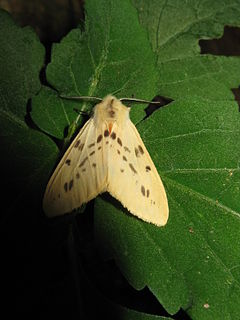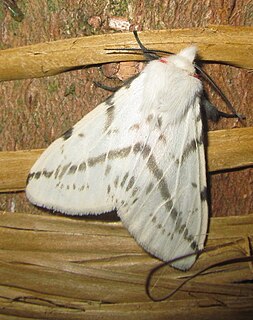
Lemyra is a genus of tiger moths in the family Erebidae. The genus contains many species from East and South Asia, Sundaland and Australia. It was described by Francis Walker in 1856.
Lemyra burmanica is a moth of the family Erebidae. It was described by Walter Rothschild in 1910. It is found in China.
Lemyra costimacula is a moth of the family Erebidae. It was described by John Henry Leech in 1899. It is found in China.
Lemyra diluta is a moth of the family Erebidae. It was described by Thomas in 1990. It is found in China.
Lemyra flammeola is a moth of the family Erebidae. It was described by Frederic Moore in 1877. It is found in China.
Lemyra flaveola is a moth of the family Erebidae. It was described by John Henry Leech in 1899. It is found in western China.
Lemyra gloria is a moth of the family Erebidae. It was described by Cheng-Lai Fang in 1993. It is found in Yunnan, China.
Lemyra heringi is a moth of the family Erebidae. It was described by Franz Daniel in 1943. It is found in Yunnan, China.
Lemyra melanosoma is a moth of the family Erebidae. It was described by George Hampson in 1894. It is found in China, Pakistan, eastern India, Myanmar and Thailand.
Lemyra melli is a moth of the family Erebidae. It was described by Franz Daniel in 1943. It is found in China.

Lemyra multivittata is a moth of the family Erebidae. It was described by Frederic Moore in 1865. It is found in Nepal, India, Myanmar and China.
Lemyra neglecta is a moth of the family Erebidae. It was described by Walter Rothschild in 1910. It is found in India, Nepal, Myanmar and China.
Lemyra pilosoides is a moth of the family Erebidae. It was described by Franz Daniel in 1943. It is found in the Chinese provinces of Yunnan and Sichuan.
Lemyra phasma is a moth of the family Erebidae. It was described by John Henry Leech in 1899. It is found in China and possibly northern Vietnam.
Lemyra rhodophila is a moth of the family Erebidae. It was described by Francis Walker in 1864. It is found in China (Tibet), Pakistan, India, Myanmar and Nepal.
Lemyra rubidorsa is a moth of the family Erebidae. It was described by Frederic Moore in 1865. It is found in Pakistan (Kashmir), India and China.
Lemyra sikkimensis is a moth of the family Erebidae. It was described by Frederic Moore in 1879. It is found in India and China.
Lemyra sincera is a moth of the family Erebidae. It was described by Cheng-Lai Fang in 1993. It is found in Yunnan, China.

Lemyra stigmata is a moth of the family Erebidae. It was described by Frederic Moore in 1865. It is found in China, Pakistan, India, Nepal, Bhutan, Myanmar, Thailand and Vietnam.
Spilarctia zhangmuna is a moth in the family Erebidae. It was described by Cheng-Lai Fang in 1982. It is found in Yunnan and Tibet in western China.


